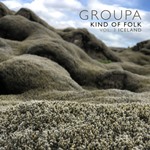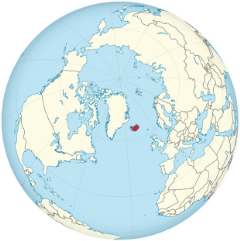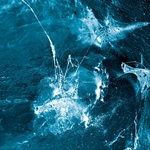

Once again, Swedish folk trio Groupa explores new frontiers. The third installment in the Kind of Folk series sets its focus on Iceland. Join Groupa on the next step of their musical trek and discover what they experienced on fields of lava, in bracing winds and with the ancient magic of rímur...

The music of Iceland includes vibrant folk and pop traditions, as well as an active classical and contemporary music scene. Well-known artists from Iceland include medieval music group Voces Thules, alternative rock band The Sugarcubes, singers Björk, Hafdís Huld and Emiliana Torrini, post-rock band Sigur Rós, post-metal band Sólstafir, indie folk/indie pop band Of Monsters and Men, blues/rock band Kaleo, metal band Skálmöld and techno-industrial band Hatari. Iceland's traditional music is related to Nordic music forms. Although Iceland has a very small population, it is home to many famous and praised bands and musicians.


Icelandic music has a very long tradition, with some songs still sung today dating from 14th century. Folk songs are often about love, sailors, masculinity, hard winters, as well as elves, trolls and other mythological creatures, and tend to be quite secular and often humorous. Bjarni Þorsteinsson collected Icelandic folk music between 1906 and 1909, and many of the songs he encountered were accompanied by traditional instruments like the langspil and fiðla, which are among the few musical instruments traditionally played in Iceland. Chain dances, known as víkivaki, have been performed in Iceland since the 11th century at a variety of occasions, such as in churches and during the Christmas season. An example is "Ólafur Liljurós", an Icelandic víkivaki folk song dating to the 14th century, about a man who, while on his way to meet his mother, is seduced, kissed, and stabbed by an elf woman while riding his horse, then eventually dies.
Iceland's isolation meant that, until the 18th century, foreign influences were almost completely absent, which resulted in the maintenance of a particular rhythm, called hákveða, lost in other Nordic countries and considered one of the main characteristics of Icelandic folk music. Hákveða refers to a special emphasis placed on some of the words of a song, often the last word of each sentence in each verse. In the following example, taken from the song "Ólafur Liljurós", hákveða is shown in italics:
Rímur are epic tales sung as alliterative, rhyming ballads, usually a cappella. Rímur can be traced back to the Viking Age Eddic poetry of the skalds and employs complex metaphors and cryptic rhymes and forms. Some of the most famous rímur were written between the 18th and early 20th centuries, by poets like Hannes Bjarnason (1776–1838), Jón Sigurðsson (1853–1922) and Sigurður Breiðfjörð (1798–1846).
In the early 18th century, European dances like polka, waltz, reel and schottische begin to arrive via Denmark. These foreign dances are today known as gömlu dansarnir or literally the "old dances". After their arrival, native dance and song traditions fell into serious decline. For a long time, rímur were officially banned by the church. Paradoxically, many Icelandic priests were keen in making rímur. Rímur remained popular recreation until the early 20th century. In recent years, efforts have been made to revive native Icelandic forms. For example, a modern revitalization of the Rímur tradition began in 1929 with the formation of the organization Iðunn.
Protestantism has also left its mark on the music of Iceland. Hallgrímur Pétursson wrote numerous Protestant hymns in the 17th century. In the 19th century, Magnús Stephensen brought pipe organs to Iceland, soon to be followed by harmonium pumped reed-organs. "Heyr himna smiður" ("Hark, Creator of the Heaven") is probably the oldest psalm which is still sung today; it was composed by Kolbeinn Tumason in 1208.
The music of Iceland includes vibrant folk and pop traditions and is expanding in its variety of sound styles and genres. Well-known artists from Iceland include alternative rock band The Sugarcubes, singers Björk, Hafdís Huld and Emilíana Torrini, and post-rock band Sigur Rós, as well as electronic music groups like GusGus. Iceland's traditional music is related to Nordic music forms.
Icelandic popular music today includes many bands and artists, ranging from indie and pop-rock to electronic music. It is also increasingly becoming recognized for its vibrant and growing metal and hardcore scene.
One widely known Icelandic artist is eclectic singer and composer Björk, who has received 13 Grammy nominations and sold over 15 million albums worldwide, including two platinum albums and one gold album in the United States. Another is the post-rock formation Sigur Rós and its lead singer Jónsi. Widely known outside Iceland, they were immortalized in an episode of The Simpsons and more recently in an episode of Game of Thrones.
The national anthem of Iceland is "Lofsöngur", written by Matthías Jochumsson, with music by Sveinbjörn Sveinbjörnsson. The song, in the form of a hymn, was written in 1874, when Iceland celebrated the one thousandth anniversary of settlement on the island. It was first published under the title "A Hymn in Commemoration of Iceland's Thousand Years".
Iceland hosts a variety of music festivals. The biggest festival is Iceland Airwaves with over 9000 guests. It takes place in the central area of Iceland’s capital city Reykjavík for five days at the beginning of November. There is also an up-and-coming festival, Secret Solstice, which was held for the first time in the summer of 2014, June 20–22. The festival took place at the Laugardalur recreational area, also known as Hot Spring Valley, which is located just 15 minutes from downtown Reykjavik. There are also a number of intimate and transformative festivals that happen year-round in the countryside, such as Saga Fest in Selfoss and LungA Art Festival in Seyðisfjörður.
Other festivals are:
Icelandic folk music includes a number of styles that are together a prominent part of the music of Iceland. When speaking of traditional Icelandic vocal music, there are two prominent vocal performance styles, one using the term kveða and the other syngja. The first is a performance practice referred to as kveðskapur or kvæðaskapur. Kveðskapur is also the generic Icelandic term for poetry. The term syngja translates as to sing. Kveðskapur was very connected to sagnadansar, or traditional dancing (literally "story dancing"). Víkivaki is the best known of the sagnadansar, and its origin can be traced to the 11th century. Víkivaki saw a decline at the beginning of the 20th century, although efforts are being made to keep it alive.
While the prevalence of instrumental music before the 20th century is widely debated, folk instruments include the langspil and fiðla (Icelandic fiddle). Both instruments are in the zither family and are primarily played with a bow. Though very little is known about the fiðla, the langspil is closely related to the pan-European Scheitholt and Appalachian dulcimer.
Traditional Icelandic folk music remained widely performed into the last decades of the 19th century, when folk collecting began in the country. However, the advent of Western classical music and other foreign influences in the same period began leading to a decline in traditional music. Later, the arrival of popular music furthered this change; some folk music was recorded between the World Wars, but intense collecting did not begin in earnest until recently.
Rímur is a type of epic vocal poem, with fixed diatonic melodies (except in Breiðafjörður, the district where the traditional music is oldest in style, and folk melodies are variable, not based on fixed scales). Rímur melodies (rímnalög, kvæðalög, stemmur) are often standard, and found throughout the country. These epic poems are written in a narrative style, using elements of Icelandic literature and folklore. The performers were lauded for their ability to tell a story in verse.
A rímur verse is made up of trochaic lines which use literary techniques such as rhyme and alliteration. There are between two and four lines with a pattern of syllabic stress and alliteration. Music author Hreinn Steingrímsson describes rímur this way:
The four-line metres are a combination of two couplets with four stressed syllables in the first line of each, and two such syllables (first and third, second and third, or third and fourth) alliterate with the first stressed syllable of the second line.
The earliest known text of a rímur dates to the 14th century; for the subsequent six hundred years, the rímur texts were the most prolifically produced form of Icelandic literature. Rímur melodies date back to publications by folklorist Ólafur Davíðsson and were then collected in the first Icelandic folk music collection, Íslenzk þjóðlög, by Bjarni Þorsteinsson.
Rímur, especially the short four-line metres form "ferskeytla", is still very popular today in Iceland in most social groups. It is common to put together a ríma (setja saman stöku) about current events usually in the form of a joke or ridicule. These short rhymes tend to proliferate via email. It is also common during parties that a guest may say a ríma that he has learned or composed as a form of a joke, often an insult. Skill at composing rímur is often admired. A common game is to tell the first part ("fyrri partur", the first two lines) of a ríma, and for others to complete the third and fourth lines (to "botna"), each in their own way. The one whose "botn" is the cleverest wins. This game can become a serious competition (known as "kveðast á") when two or more who are particularly skilled at composing rímur come together. It is an informal rule that if one is ridiculed or even insulted with a ríma he must answer back in kind; any other form of answer is invalid. Use of rímur as a form of joke or games is most common in relation to inland travel and sports such as horsemanship but also in relation to cultural/seasonal periods like Þorri as well as in political circles. Many members of parliament pride themselves on being good at composing rímur and using them to ridicule each other, or opposing parties, in a friendly manner.

Text is available under the Creative Commons Attribution-ShareAlike License.
Date: June 2020.
Photo Credits:
(1)-(3) Groupa (by Peter Lloyd);
(4) Iceland,
(5) Krauka,
(6) Myrra Rós,
(7) Ragga Gröndal,
(8) Árstíðir,
(9) Svavar Knútur
(unknown/website).